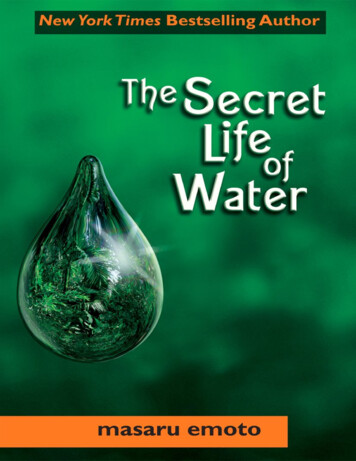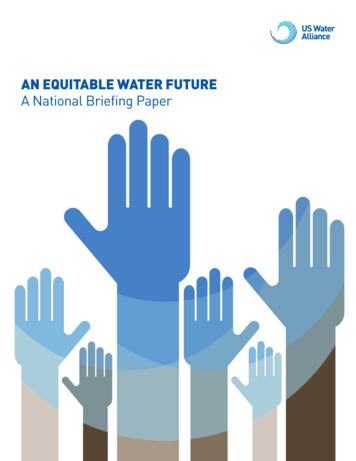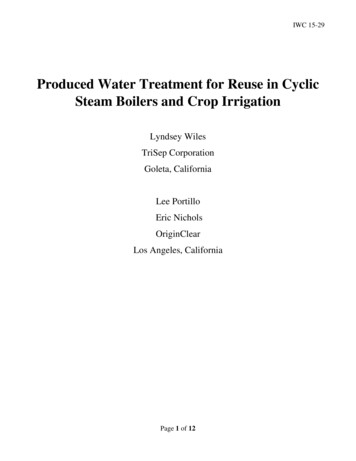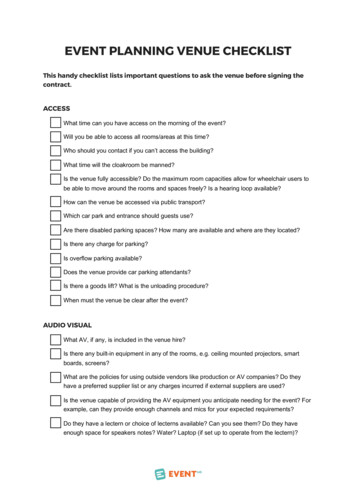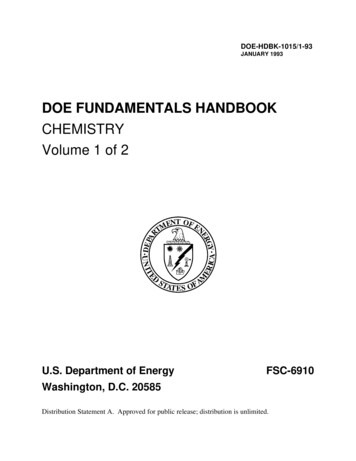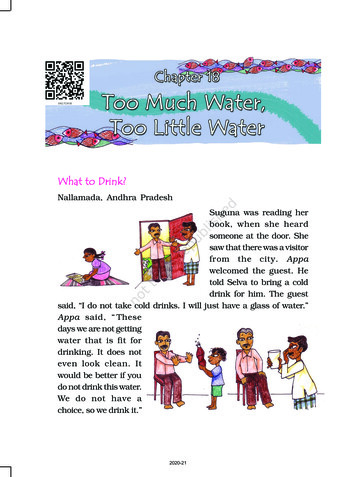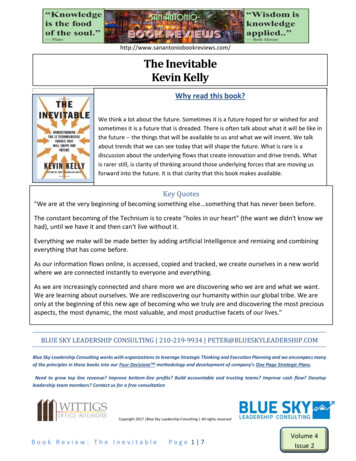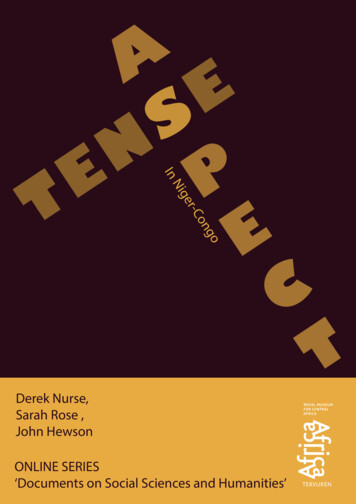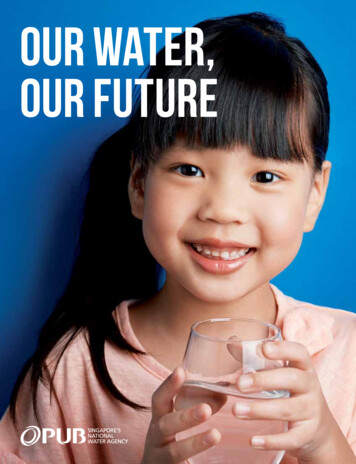
Transcription
Our Water,Our Future
CONTENTS02FOREWORD04CHAPTER 118CHAPTER 226CHAPTER 332CHAPTER 440CHAPTER 5WATER FOR ALLIN THE PIPELINEKEEPING SINGAPORESUSTAINABLE ANDRESILIENTWATER AND ALIVEABLE CITYOUR WATER FUTUREFirst published in June 2016 by PUB Singapore. Revised editionreprinted in January 2018. No reproduction is permitted in whole orin part without written permission from PUB. Copyright is heldby the publishers.
FOREWORDA Water-Stressed CountryIn 2015, the Water ResourcesInstitute (WRI) ranked Singaporeas one of the most water-stressedcountries in the world. It thinksthat, by 2040, Singapore would beone of eight countries in the worldmost vulnerable to disruptions inwater supply.Water planners in PUB arenot in the least surprised by theWRI’s conclusion, although I suspectthat even a reasonably wellinformed Singaporean would find itincredible. Because the notion thatour water taps could run dry is justinconceivable to most Singaporeansalive today.These same Singaporeanswould probably be taken abackwhen told that, for a good fivemonths – from August 2015 toJanuary 2016 – some 600,000consumers went without wateras rationing was imposed in PasirGudang and Kota Tinggi. Just 30 kmacross from the causeway as the02Our Water, Our Futurecrow flies, these districts in JohorBahru would have received prettymuch the same amount of rain as wedid in Singapore. Even so, more thanhalf a million there had to endure theagony of a “one-day-on-two-day-off”scheduled supply for months on end.The fact that imported water –which can meet half of Singapore’sdaily demand for drinking water –is under threat and steadilydepleting, but has no impact for theSingaporean end consumer is anunappreciated blessing. For sure, thishappy outcome is not due to goodfortune, but the direct consequenceof long careful planning and carefulimplementation by PUB and otherparts of government.We expect total demand forwater to double by 2061, when ourremaining water agreement withMalaysia will end. This is water thatwe do not have now. Water that wewill need to find and to treat.The reader will readilyappreciate that Singapore’scontinued ability to ensurewater security and sustainabilityguarantees our national survival andeconomic prosperity. This was thecase at independence, as it is now, asit will be in the future.The simple fact is that there isnot enough room on Singapore tocollect and store all the water thatwe need. As such, although righton the equator and in the tropics,Singapore is actually a severelywater-challenged country, as theWRI has observed. Fortunately, aslong as we remain clear-eyed aboutour nation’s water situation, are ableto devise an intelligent strategy andthen execute it conscientiously, thereshould always be enough water.This updated edition of “Our Water,Our Future” explains how.Our Water StrategySingapore’s water strategy comesin three parts. First of all, we haveto maximise our own yield. And sowe strive to collect every drop of
rain that falls on Singapore. Thismeans turning as much of Singaporeas possible into a water catchment,and keeping our drains, canals andwaterways pristinely clean.Secondly, we have to thinkof water as an endlessly reusableresource. In our minds, the H2Omolecule is never lost. Water canalways be reclaimed and retreatedso that it can be drunk again. PUBis a world leader in this. We reclaimevery drop of sewage and turn muchof it into potable water again.And thirdly, because Singaporeis surrounded by sea, we can turnseawater into drinking water. Andwe continue to research betterdesalination technology to find evencheaper ways of desalting water.PUB, Singapore’s Water AgencyPUB is the national water agency,the sole water utility and the agencyresponsible for realising Singapore’swater strategy. Our mission is astraightforward one. By supplyinggood water, reclaiming used waterand taming stormwater, PUB officersmake everyday life possible. In thePUB, our vision is a Singapore thatwill always have enough water andfor Singaporeans to cherish everydrop of water.A Good OutcomeThis “Our Water, Our Future”publication describes, in somedetail and in an engaging way,how we manage the water systemin Singapore so that we canguarantee everyone in Singaporewill have enough clean water, so thatwastewater is collected and properlytreated, and that stormwater isproperly channelled and stored.It will become quickly apparentto the reader that the future ofSingapore’s water security lieswith desalination and reuse. Atthe same time, he will also realisethat the Singapore water systemmust forever remain adequate,sustainable and resilient.This is entirely practicable, aslong as we remain coldly realisticabout our circumstances and donot shy away from pursuing andemploying hard-nosed policies. It willrequire that we apply our intellectand imagination, researching andtesting continuously, and use scienceand technology to overcome ourwater challenges. And it will requirejudicious consumption and increasedfrugality on the part of Singaporeansand residents.Then, in this remarkable way,Singapore will be always able toturn what is a disadvantage intostrength, and what seemed anunsurmountable vulnerability intoendless opportunity.NG JOO HEEChief ExecutivePUB, Singapore’s National Water AgencyOur Water, Our Future03
CHAPTER 1WATERFOR ALLTurn on a tap at home at any time and youcan get all the drinking water that you need.While some countries are struggling toprovide enough clean drinking water for theirpeople, Singaporeans have little fear thattheir homes and workplaces will run dry.This was not always the case.More than 50 years ago, someof us queued in the streets forwater during water rationing causedby prolonged dry spells. At othertimes, heavy downpours led towidespread flooding that wreckedhomes and destroyed lives.In just a few decades, PUB,Singapore’s national water agency,has transformed Singapore’s watermanagement by tapping technologyand embarking on ambitiousengineering projects. We are now inthe midst of another evolution.04Our Water, Our FutureAt first, we took nature’s bountyby storing and treating rainwater.Then, we collected the used waterthat flows into sinks and sewers as wego about our daily lives, and turnedit into NEWater, our own brand ofultra-clean, high-grade reclaimedwater. Ten years ago, we beganbuilding desalination plants, turningseawater into drinking water.In Singapore’s 50 years ofindependence, we have turnedour water vulnerability into astrategic asset. We created theFour National Taps – water from local
catchments, imported water fromMalaysia, NEWater and desalinatedwater – to diversify and strengthenour water supply. Our technologyinvestments gave us NEWater anddesalinated water, two weatherresilient sources that saw us throughone of Singapore’s driest periods inearly 2014.Still, challenges lie ahead. Ourweather has become more erratic,with dry spells spanning weeks at atime in recent years. More intensestorms at other times threatened tooverwhelm our drainage systems.Dry weather in recent years ledto record low water levels at theLinggiu Reservoir in Johor, which06Our Water, Our FutureSingapore built and operates underthe Water Agreement. This couldreduce Singapore’s ability to drawand use water from the Johor River.As we produce more waterfrom desalinated seawater andNEWater, our energy needs forthese treatment processes are alsoexpected to rise.These issues will become morepressing as our population andeconomy continue to grow. As weforge ahead in the next 50 years,our vision is to ensure that ourwater supply continues to be robust,sustainable and affordable.
WATER FOR ALLWAT E R D E M A N D :TO DAYFU T U R EANDBy 2060, Singapore’s water use is expected to double from about 430million gallons a day (mgd) now. We will increase our water recycling anddesalination capacity to meet the rising demand. Together, these twosources will supply up to 85% of our future water needs.Water Demand and csector45%Non-domesticsector55%Demand in 2060Demand in 2030Demand NowSupply NowWater fromlocal catchmentImported waterNEWater [Up to 40%]*Desalinatedwater [Up to or60%Supply in 2030Water fromlocal catchmentImported waterNEWater [Up to 50%]*Desalinatedwater [Up to 30%]*Supply in 2060Water fromlocal catchmentImported waterNEWater [Up to 55%]*Desalinatedwater [Up to 30%]** denotes % of demandOur Water, Our Future07
FOURN AT I O N A LTA PSL O C A L WAT E RC ATC H M E N T SWith good planning, rain can be a gift. Most rainwaterthat falls on Singapore is whisked through drains, canals,rivers and ponds to our 17 reservoirs for storage, and thentreated to become drinking water. Two-thirds of Singaporeis water catchment, making us one of just a few countries inthe world to harvest urban stormwater on a large scale forconsumption. To prevent contamination, our used water iscollected in a separate underground sewerage system.17reservoirsfor storageof Singaporeis a watercatchmentIMPORTEDWAT E RSingapore imports water from Johor under the 1962 WaterAgreement, which allows Singapore to draw up to 250 mgdfrom the Johor River until 2061.08Our Water, Our Future
WATER FOR ALLN E WAT E RWaste not, want not – the idiom is true in water too. TheNEWater process recycles our treated used water into ultraclean, high-grade reclaimed water, cushioning our water supplyagainst dry weather and moving Singapore towards watersustainability. The used water is treated and put throughmicrofiltration and reverse osmosis to remove contaminants,bacteria and viruses, and then disinfected with ultraviolet lightas an additional barrier.NEWater has passed more than 150,000 scientific tests,and is well within drinking water guidelines set by the UnitedStates Environmental Protection Agency (USEPA) and theWorld Health Organization (WHO). It is mainly used in waferfabrication parks, industrial estates and commercial buildingsfor cooling and industrial processes.NEWater can now meet about 40% of Singapore’swater needs. During dry months, we also top up reservoirswith NEWater, and further treat the blended water at thewaterworks before supplyingit to the population. NEWater is2060the pillar of Singapore’s waterNEWatersustainability, and by 2060, wewill meet up towill expand its capacity to meetup to 55% of our future waterneeds.of Singapore’swater needs55%D E S A L I N AT E DWAT E REven if the skies dry up, we can always look to the sea.Desalinated water, or treated seawater, however, is the mostenergy-intensive of the Four National Taps and so the mostexpensive to produce. Two desalination plants with a combinedcapacity of 100 mgd can now meet 25% of Singapore’swater needs.By 2020, we will build threemore 30 mgd desalination plants2060at Tuas, Marina East and JurongIsland to boost our droughtDesalinated waterresilience. We plan to double ourwill meet up todesalination capacity by 2030, andtriple it by 2060 to meet up to 30%of our future water needs.of Singapore’swater needs30%N E WAT E R ,NOTHING NEWNEWater’s genesis dates back to the 1970s, whenthe Singapore government commissioned a study todetermine the feasibility of producing reclaimed water.Although the study found it was technically possible,the technology’s high cost and unproven reliability thenwere insurmountable concerns.By the 1990s, however, membrane technology’scost and performance had improved considerably.Other countries such as the United States werealso increasingly using it for water treatmentand reclamation.In 1998, PUB set up a team to test the latestproven membrane technology’s use in water reclamationfor potable purposes. Two years later, it commissioned afull-scale demonstration plant that could produce10,000 cubic metres (m3) of water daily.The high-grade, reclaimed water was christenedNEWater, and a battery of tests and audits showed itwas a safe and sustainable water source.An international group of experts in engineering,biomedical sciences, chemistry and water technologyalso found that NEWater’s quality was consistentlysafe and high, and well within the WHO and USEPA’srequirements for drinking water. They recommended itfor indirect potable use, to be introduced into raw waterreservoirs. The blended water undergoes naturalisationand further treatment in conventional waterworks tocreate drinking water.In 2003, we launched NEWater with the openingof the first two NEWater plants at Bedok and Kranji,and the NEWater Visitor Centre, a water museum toshowcase our journey towards water sustainability.The rest, as they say, is history.Our Water, Our Future09
THE WATER L OOPStormwater managementRainTreatment of usedwater at 4 waterreclamation plants 4SeaIndirect potable use5 NEWater factories2 Desalination plants3Collection of rainfall in17 reservoirs1Direct nonpotable usethrough 515kmtransmissionnetworkCollection of used water in3,500km of sewers and DTSSIndustryTreatment of raw topotable water at 8 PUBwater treatment plants2Transmissionand distributionnetwork(5,500km)Households1Refers to waterbodies in Singapore2Includes one water treatment plant in Johor3Three more desalination plants will be built by 2020.4It is envisaged that there will only be 3 water reclamation plants in the longterm, with the completion of the Deep Tunnel Sewerage System Phase 210Our Water, Our Future
WATER FOR ALLK E Y S T R AT EG IE SI N P L AC ESingapore’s water policies have evolved over the years as the focusshifted from survival to sustainability. Our holistic approach to watermanagement, however, can be distilled into three key strategies:1Collect everydrop of waterAs a city-state with scarce land, we have to makeevery drop of rain count. Our separate rainwater andused water infrastructure, good land use planningpolicies and strong environmental controls alsoprotect the collected rainwater from pollution.3DesalinatemoreseawaterAs an island surrounded by thesea, desalination is a natural optionfor Singapore, especially whenmembrane technology has made iteconomically viable. We will continueinvesting in research and technologyto find better and less expensiveways of desalting seawater.2Reuse waterendlesslyWater can always be reclaimed and retreatedso it can be used again. PUB is a world leaderin this. Recycling water is the most sustainableand cost-effective way to increase our watersupply, and it also does so exponentially.To increase the recycling rate, we will:Further close the water loop by reclaimingused water from industrial sources for nonpotable use. Such water is now treated anddischarged to the sea;Increase water recovery from waterreclamation and NEWater treatment. TheNEWater process currently turns 75% of feedwater into NEWater;Reduce losses from PUB’s supply byencouraging seafront companies on JurongIsland to use seawater for cooling processes,instead of freshwater.Our Water, Our Future11
S CIEN CETO T H E R E S C U E12Our Water, Our Future
WATER FOR ALLInvesting in research and technology unlocked watersolutions for Singapore, and that continues to be key.When the public and private sectors work closely, we candevelop ways to keep our water supply sustainable andaffordable. These are some areas we are exploring:Singapore’s current desalination method is reverse osmosis,which uses 3.5 kWh/m3. The process pushes seawater throughmembranes that filter out dissolved salts and minerals,resulting in pure drinking water. If we continue to use thismethod, however, Singapore’s desalination energy use in 2060will be four times greater compared to now.Electro-deionisation could reduce desalination’s energyuse and cost. This method uses an electric field to pull dissolvedsalts, which have a positive or negative charge, from water.PUB and United States-based Evoqua Water Technologies(formerly Siemens Water) successfully piloted the technology todemonstrate an achievable energy consumption of 1.65 kWh/m3at a 50 m3/day pilot plant. Plans are in place to further scale upthe technology and demonstrate it at a 3,800 m3/day facility inTuas by the end of 2018.Another exciting research field is based on biomimicry,or the mimicking of biological processes by which mangroveplants and euryhaline fish extract freshwater from seawaterusing negligible amounts of energy. PUB’s goal is to halvedesalination’s energy use.ANODE ( ) EXCHANGECI- –CICICICI-–NaNa– Na CICI-––CI MEMBRANE SEAWATERCI-CATION EXCHANGE–Na CINa ––––ANIONEXCHANGE– –MEMBRANEBRINECATHODE (-)MEMBRANECI- Na CATION–Na Na Na Na Na –––––PRODUCTElectro-deionisation uses an electric field to remove dissolved salts(Na Cl-) from water, reducing desalination’s energy use and cost.Illustration credit: iStock.comL OW- E N E R G YD E S A L I N AT I O NTA K I N G A L E A FF R O M N AT U R ESometimes, nature knows best. Aquaporinsare proteins in living organisms that shuttlewater in and out of cells while blockingsalts. Biomimetic membranes enhancedby aquaporins could desalinate seawatermore efficiently than current technology.Nanyang Technological University’sSingapore Membrane Technology Centrewas among the world’s first to createprototypes of a durable and aquaporinbased membrane for water reuse anddesalination. The scientists’ inventionoutdid commercial reverse osmosismembranes for brackish water andseawater, and they are now refiningtheir work.A new research area called syntheticwater channels could also improve waterseparation and purification. Inspired bynatural proteins such as aquaporins, theycould be more stable and scalable sincethey are completely artificial and henceeasier to manufacture and integrate intoengineering systems. PUB awarded threeproposals on this new research area in2016.Our Water, Our Future13
AU T O M AT I O NA N D R O B OT I C S14Our Water, Our Futurehas been deployed in our potablewater networks and PUB is planningto expand the system to cover ourNEWater network. The systemprovides decision support tools thatwill help in network management,and allows early detection of networkoccurrences, enhancing PUB’soperations and the efficiency of watersupply to consumers.PUB’s other projects include theNUSwan, a robotic swan developedwith NUS to monitor our reservoirs’water quality, and UAVs for securitysurveillance at plants and reservoirs.Image credit: NUSFrom sensors to artificial swans,robotics and automated systemscan help us minimise humanerror and redeploy manpowerto more productive tasks. In the1980s, PUB developed a long-termcomputerisation plan for its systems.It has since completed manyautomation projects, and is workingon more.Robots that can cope withdifferent tunnel conditions andan unmanned aerial vehicle (UAV)system are being developed toinspect and maintain the DeepTunnel Sewerage System. Wehave also installed about 1,000sensors and 20 flow gauges insewer manholes island-wideto detect potential sewer andoverflow problems.About 320 sensors helpus to monitor the water qualityand pressure in the water supplydistribution network in real-time.This Smart Water Grid, developedby PUB and local firm Visenti,Illustration credit: iStock.comI M P R OV I N GN E WAT E RR ECOV E RYWe produce NEWater by putting treated usedwater through microfiltration, reverse osmosisand ultraviolet light (MF-RO-UV). Our three-stageprocess is one of the most efficient ways to recycleused water and has a recovery rate of 75%, but thegoal is a sustainable 90% rate.Electrodialysis reversal-reverse osmosis(EDR-RO) could be an alternative. Similar to electrodeionisation, it uses an electric field to removecharged pollutants from used water. PUB, theNational University of Singapore (NUS) and UnitedStates-based GE Water and Process Technologiesare currently piloting an EDR-RO system at the UluPandan Water Reclamation Plant.The NUSwan helps to monitor water quality in our reservoirs.
WATER FOR ALLREDUCING ENERGYI N U S E D WAT E RT R E AT M E N TIf we can minimise the energy needed to treat used water and recovermore energy from the process, the treatment could use only as muchenergy as it generates. For instance, biogas produced from usedwater treatment can be harvested to generate power and offset thetreatment’s energy cost.Other methods are promising. An upflow anaerobic sludge blanket(UASB) uses microorganisms to break down organic particles in usedwater. Unlike some processes, it does not require oxygen, so there is noneed for energy-intensive aeration. It also produces biogas.Anaerobic membrane bio-reactors (AnMBR) and anaerobicammonium oxidation (Anammox) also avoid using oxygen and couldgenerate more biogas.In 2014, PUB opened a 1 mgd demonstration plant at theJurong Water Reclamation Plant to test UASB-MBR technologies thatcould recycle industries’ used water and use less energy.W H E N WA S T E I SUASB-MBR demonstration plant at the Jurong Water Reclamation Plant.Illustration credit: iStock.comImage credit: Meiden SingaporePOWERPeople aren’t the only ones who work betterwith some food in them. In 2015, Singaporeannounced its first co-digestion plant. It willprocess used water sludge and food waste toproduce more biogas for electricity generation.PUB’s water reclamation plants now breakdown the sludge to produce biogas, but addingfood waste to the mix could create morebiogas due to food’s higher calorific value.The demonstration plant, a collaborationbetween PUB and Canada-based energy firmAnaergia, can treat 40 tonnes of combinedfood waste and used water sludge, and doesnot use oxygen to convert them into biogas,saving energy. Used water treatment plantscould become energy self-sufficient withthe help of this technology. If successful,it could be deployed at the future TuasWater Reclamation Plant and the NationalEnvironment Agency’s Integrated WasteManagement Facility.Our Water, Our Future15
By 2060, homes will make up just 30% of Singapore’swater demand, with the non-domestic sectoraccounting for the rest. Managing industrial wateruse is thus a priority, especially as Singaporealso hosts water-intensive businesses likepetrochemicals, electronics and pharmaceuticals.By understanding the water needs of variousindustries in Singapore, we can promote innovativetechnologies and water audits to help them maketheir facilities and manufacturing processes morewater-efficient. When firms reduce their waterfootprint, use alternative water sources such asseawater, and maximise their water recovery byreclaiming waste streams, they make every drop ofwater count and reduce their water costs too.2060Non-domestic sectorwill make up70%of Singapore’swater demand16Our Water, Our FutureU S I N G S E AWAT E R F O RCO O L I N G P U R P O S E SAbout one-tenth of Singapore’s water demand now comesfrom Jurong Island, which is home to more than 100 petroleum,petrochemical, specialty chemical and supporting companiesthat use 40 million gallons of water daily. However, a largeportion of water supplied to industries is lost to the atmospherefrom cooling processes, which reduces the amount that can becollected for reuse. PUB has completed a feasibility study on theuse of seawater to meet future cooling demand. We are workingwith agencies such as JTC Corporation and the EconomicDevelopment Board to promote the use of seawater for coolingpurposes on Jurong Island.Firms can also do more to boost their water efficiency. Byattending water-related networking events and seminars, theycan learn about best practices, and existing, new and emergingtechnologies that can reduce their water needs. These platformsinclude the annual Industrial Water Solutions Forum and theIndustrial Water Solutions Seminar Series.Two exemplary companies on Jurong Island have stood outfor their water-saving efforts. The Singapore Refining Company(SRC) started building an Effluent Treatment Recycling Plant in2015 to produce NEWater-grade water for non-potable use. Theproject was completed in 2016, and helps the company to reduceits NEWater use by up to 2,000 m3/day.The Petrochemical Corporation of Singapore’s (PCS) tradeeffluent recycling and reuse project will also reduce its NEWateruse by 1,200 m3/day when completed by early 2018. Thesetreatment and recycling projects’ success will instill confidencein the technologies and processes, and encourage other firms toadopt them.Image credit: JTCINDUSTRIALWAT E RS O LU T I O NS
Image credit: JTCWATER FOR ALLA CO M M U N I T YO F CO - C R E AT O R SSingapore,the Global Hydrohub180More than20companiesresearchcentresIn Singapore, water is no longer just a resource – it’s also aneconomic asset. With water and environment technologiesidentified as a key growth industry in 2006, 670 million inpublic funds was secured to foster technologies and create athriving research community in Singapore over 15 years.Today, Singapore has 180 water companies and morethan 20 water research centres. These include home-grownfirms that can compete overseas, having built a track recordin producing NEWater and desalinated water for PUB underDesign-Build-Own-and-Operate arrangements. The private andpublic sectors collaborate on R&D projects, firms can test theirtechnologies at PUB’s facilities under actual site conditions, andthere is a comprehensive plan to commercialise good ideas.Products, technologies and solutions developed inSingapore have applications worldwide, especially in the lightof urbanisation and weather changes. Solutions to complexissues require collaboration among researchers, industry, governments, policymakers and utilities. With this in mind, Singapore organises the SingaporeInternational Water Week (SIWW), a global platform for sharing and co-creatingwater solutions.Comprising the Water Leaders Summit, Water Convention, Water Expoand Business Forums, the SIWW culminates in the presentation of the Lee KuanYew Water Prize, a prestigious international award to recognise outstandingcontributions in solving global water issues.For more information on SIWW, please visit www.siww.com.sg.Our Water, Our Future17
CHAPTER 2IN THEPIPELINESecuring a steady supply of clean water isjust the first step. Subsequent steps includegetting it to homes, offices and factories,and collecting used water back for recycling.This requires an extensive and reliable networkof pipes, sewers, and other infrastructure.DemandNEWaterDesalinationTo keep ahead of Singapore’s needs,PUB looks to the future to plan its majorinfrastructure. In the next 15 years, wewill build new plants, upgrade existing onesand expand the water distribution and usedwater collection networks.With new and cutting-edge technologies, we can curbrising costs, reduce desalination’s energy use, recover moreenergy from water treatment and boost our water recyclingrate. We have identified and started several key projects forSingapore’s future.18Our Water, Our FuturePipelinesSewers
Now2030430 mgd25%175 mgd50%Capacity to meet40% of total demand100 mgdCapacity to meet25% of total demandCapacity to meet50% of total demand100%Capacity to meet30% of total demand6,100 km 200 km3,500 km 300 km*mgd: million gallons per day
Kranji WRP& DEEPTUNNELS E W E R AG ES YS T E MJurongBird ParkTuas WRP& NEWaterFactory& eReservoirBedokReservoirChangiAirportCBDEast Coast ParkNUSGardensBy TheBayChangi WRP& NEWaterFactoriesSentosaBy 2025, whenever you flush the toilet, take a shower or washthe dishes, the used water will flow into our undergroundnetwork of tunnel sewers and be channelled by gravity to one ofthree coastal water reclamation plants (WRPs) for treatment.Once DTSS iscompleted50%less landwill be occupied byused waterinfrastructure20This underground superhighwayfor used water will streamlinehow Singapore collects, treats anddisposes, or reclaims used water,freeing up precious land for highervalue uses. When it is completed,the Deep Tunnel Sewerage System(DTSS) will shrink the land occupiedby used water infrastructure by 50%.The engineering marvel,conceived in the 1990s as a longterm solution to Singapore’s usedwater needs, has won severalOur Water, Our Futureprestigious awards, includingWater Project of the Year at the2009 Global Water Awards and theASEAN Outstanding EngineeringAchievement Award 2005.Its construction spans twophases. Phase 1, completed in2008, included the 48 km-longNorth and Spur Tunnels, 60 km oflink sewers, the Changi WRP in theeast, and deep sea outfall pipesto serve Singapore’s central andeastern parts.Above: The InfluentPumping Stationlocated 60 m belowground at the ChangiWater ReclamationPlant, implementedunder DTSS Phase 1.
IN THE PIPELINEIntegrating DTSS Phases 1 and 2Proposed DTSSPhase 2 DomesticUsed Water TunnelProposed DTSSPhase 2 IndustrialUsed Water TunnelDTSS Phase 1Used Water TunnelKranji WRP& NEWaterFactoryConveyance SystemTuas WaterReclamationPlant (Tuas WRP)and IntegratedNEWater FactoryIntegrated WasteManagement JurongBird ParkTuas WRP& NEWaterFactory& eReservoirBedokReservoirChangiAirportCBDEast Coast ParkNUSGardensBy TheBayChangi WRP& NEWaterFactoriesSentosaPhase 2, to complete by 2025,extends the system to westernSingapore, including the downtownarea and upcoming developmentssuch as Tengah Town. After its40 km of tunnels and 60 km oflink sewers are completed, we willprogressively decommission theUlu Pandan and Jurong WRPs andintermediate pumping stations tomake way for other developments.The DTSS is also anopportunity to reinvent Singapore’sWRPs. The Changi WRP is one-thirdthe size of a conventional WRP anddoes not need a buffer zone becauseits treatment modules are fullycovered. Two NEWater factories arealso built on its rooftop to maximisethe land use.The new, compact Tuas WRPin Phase 2 will have even moreadvanced features to improveenergy effici
triple it by 2060 to meet up to 30% of our future water needs. DESALINATED WATER Waste not, want not – the idiom is true in water too. The NEWater process recycles our treated used water into ultra-clean, high-grade reclaimed water, cushioning our water supply against dry weather and moving

